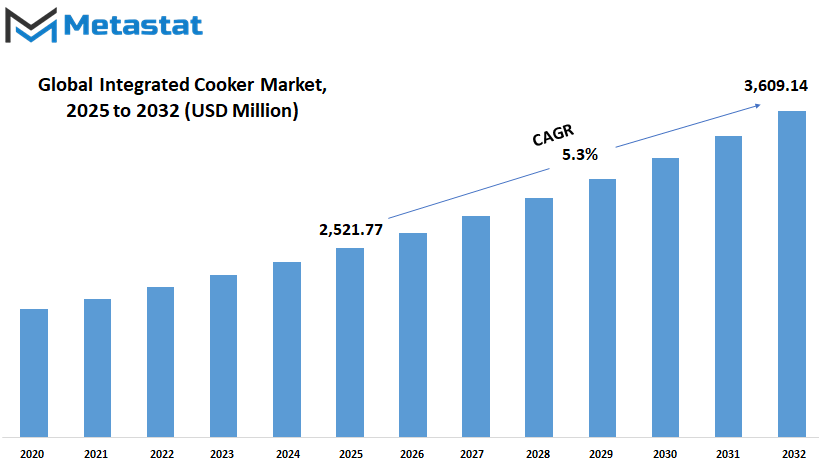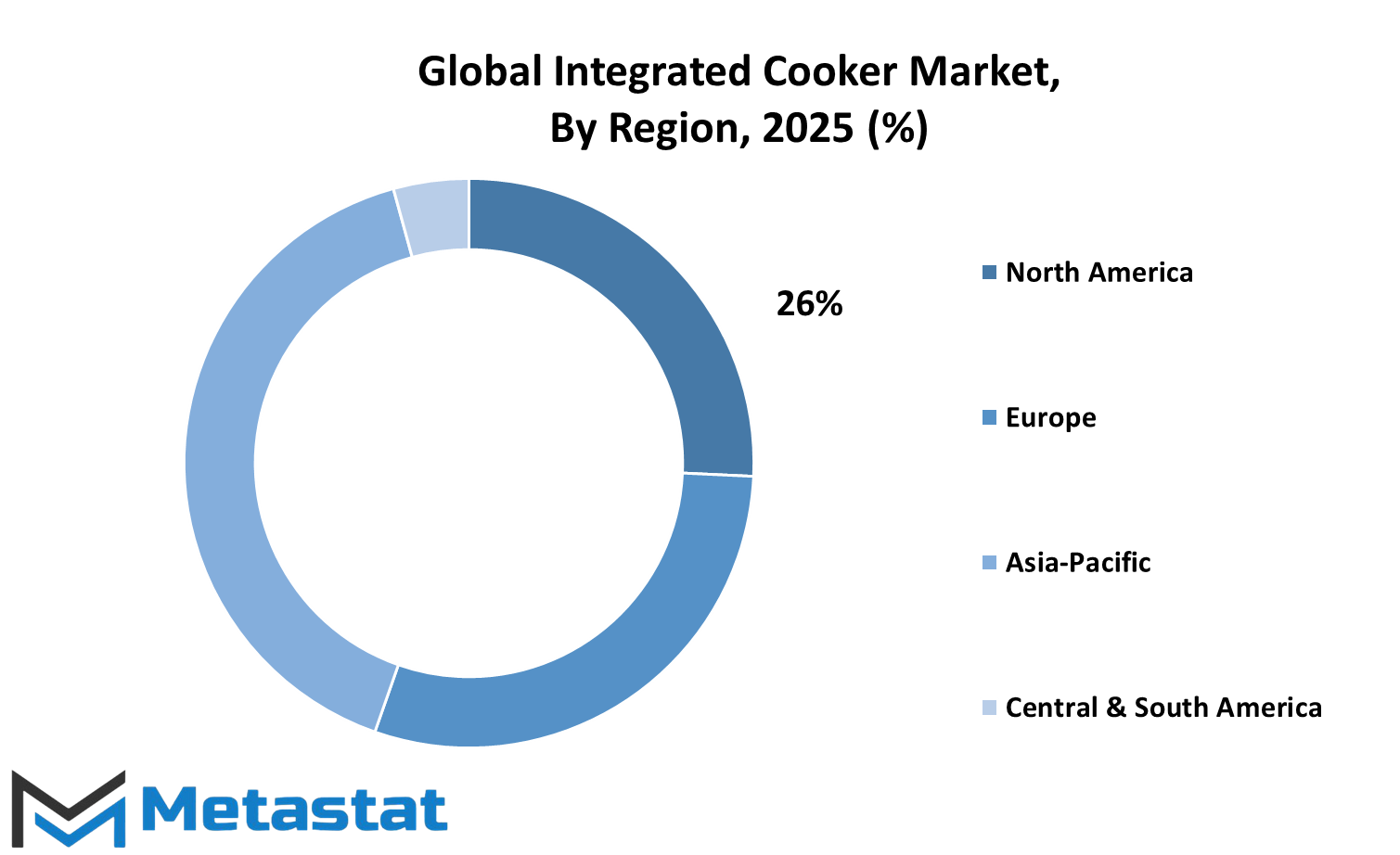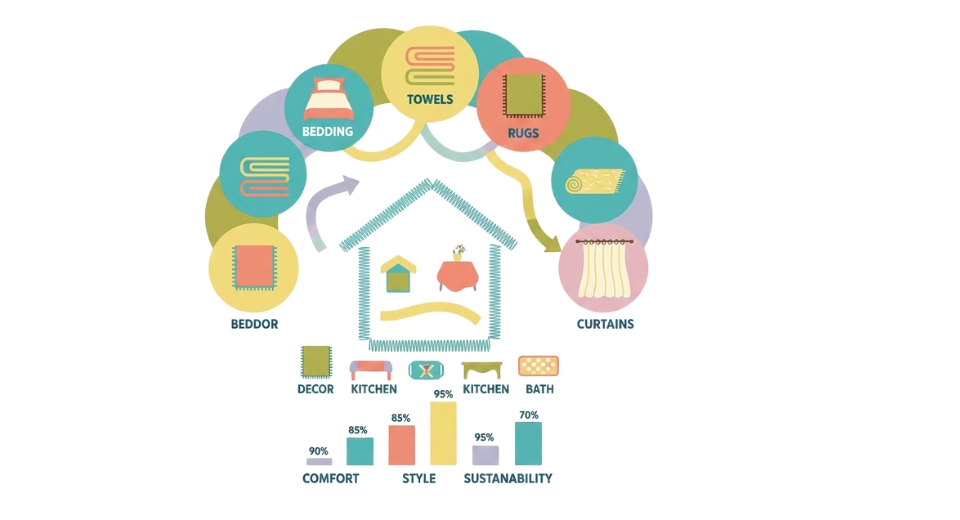MARKET OVERVIEW
The Global Integrated Cooker market is primarily driven by the general condition that deals with energy-efficient and environmentally sustainable cooking solutions, the conscience of consumers as they become more aware of the environmental footprints they leave behind. Appliances would use energy-efficient combined functions for cooking, as none of them would be required to operate individual cooking equipment, thus resulting in energy efficiency. The clutter in kitchens would also be reduced, thereby making it an even more attractive choice for some people, especially those living in small homes like apartments. Urbanization continues to fuel space-restricted kitchens and, as a result, demand for these kinds of solutions will drive the market for integrated cookers.
Integrated cookers are bringing a great revolution to the kitchen appliance sector, with innovative solutions designed to ease the cooking process, via user convenience. Integrated cookers will renovate modern kitchens by having several cooking features incorporated in a single unit. This market drives technological advancement in kitchen appliances for consumers craving space-saving and energy-efficient, multifunction appliances. One would enjoy fast, efficient, and highly personalized cooking with an integrated cooking appliance that could incorporate induction cooking, steaming, and baking.
These priorities form the basics for development and adoption of multifunctional cooking devices in the Global Integrated Cooker market. Such cookers are expected to satisfy the needs of modern families who seek convenience as well as saving space. Integrated cookers would undergo some evolution in future to cater for this as the user will be able to monitor cooking remotely by way of connectivity that will allow smart home technology adoption. Such household devices would interact and integrate with home automation systems to offer an extremely connected and personal cooking experience.
Another of its prominent characteristics will be the thrust for future smart technology in the Global Integrated Cooker market. Advanced features such as sensors, touchscreens, and voice-activated controls are optimizing future integrated cookers. Fine-tuning cooking parameters with respect to temperature, cooking time, and cooking modes will be possible through the mobile phone or the integrated home assistant because these smart features will be capable of doing that. Additionally, data analytics ensure that the devices learn user preferences and automatically adjust settings for the best cooking outcomes.
Thus, it is expected that integrated cookers will increasingly be demanded in the market, not only by households but also in the commercial sector. Integrated cookers-as central fixtures within the residential kitchen- unify various dishes and even save the space in which they are fitted. Cooking operations in commercial kitchens will be streamlined under these devices to improve efficiency while cutting down on cost equipment usage.
With the growth of integrated cookers into an ever-expanding market, manufacturers are now progressively opting for greater durability, ease of usability, and affordability. Competition within the Global Integrated Cooker market will rise with many new players entering the scene and offering many models specially tailored for different consumer tastes. The line between what integrated cookers can do will be blurred with greater integration of advanced technologies such as AI and ML, and, in turn, this will further drive the innovation rates in this space.
In summary, the Global Integrated Cooker market promises to witness a drastic scale of growth as consumers become more demanding for efficient, versatile, and kitchen-space-saving applications. The advanced technologies, smart features, and multifunctionality shall redefine cooking into something so convenient that integrated cookers shall become the backbone of the kitchen, both for individual households and commercial setups. The immediate future seems bright for this market, with the ongoing innovation and consumer-centric design taking the forefront.
Global Integrated Cooker market is estimated to reach $3,609.14 Million by 2032; growing at a CAGR of 5.3% from 2025 to 2032.

GROWTH FACTORS
The integration of modern lifestyles has made the kitchen no longer just a cooking zone, centering now on convenience, design, and technology. One such market that reflects this change is the Global Integrated Cooker market. With an ever-growing number of consumers looking for appliances that maintain a low profile in their living spaces while offering high-tech features for support in daily life, this market is seeing stable interest. Cleaning and organizing kitchens to be both functional and beautiful is the new trend, especially with shrinking urban living spaces in play. Such a shift in consumer behavior is affecting the design and marketing of kitchen appliances.
Another key factor for this trend is the increasing number of people moving into the city to reside in smaller yet well-planned homes. Increasingly urbanization is making a demand for compact appliances without compromising on performance. Integrated cookers fulfill this requirement by multitasking and blending into the kitchen design. They optimize space while adding elegance. Such types of cookers naturally come as a choice for homeowners and designers now that modular kitchens are gaining prominence across the world. Clean lines and hidden installation of integrated cookers do attract many who are designing their kitchens with beauty and purpose in tandem.
There are still a few pitfalls to overcome before more widespread acceptance can be achieved. One of the major issues is that buyers set high costs on the purchase and installation of these cookers. Integrated models, in contrast to basic stand-alone appliances, almost always require professional installation and kitchen layout modification. That really limits their appeal to some buyers, especially those with tight budgets. Another disadvantage is lack of flexibility after installation. If one wants to redesign their kitchen or convert it to a new home, the cooker may not be easy to move or to fit into a new layout. These factors make some consumers have second thoughts about integrated options.
Looking ahead, innovations continuing at a great pace promise the Global Integrated Cooker market more expectedly. Smart cookers able to connect to mobile applications or smart home systems had begun to attract attention. These appliances enhance advantages including remote monitoring, voice control, and energy savings settings. Considering an increasing population will seek comfort and environmentally friendly products, such smart features are likely to be a driving force determining demand. In the coming years, demand for integrated cookers might surge if there is progressive technology and more smart-and-stylish appliances are sought.
MARKET SEGMENTATION
By Product Type
The Global Integrated Cooker market has prospects for growth, as people continue to seek kitchen solutions that are smarter and save space. Smaller houses and the growing emphasis on modern interiors are sure to push the demand for integrated appliances, integrated cookers being one of them. These cookers save space and integrate into the kitchen design more smoothly, thus becoming attractive options for homeowners and interior designers alike. Growing innovations in materials and technology that allow manufacturers to create quiet. energy-efficient, and user-friendly products could further augment this market.
The market dynamics cut across product types that vary by kitchen setups and preferences. Wall-mounted cooker hoods will likely reach a value of approximately USD 833.97 million by 2025. The popularity of wall-mounted hoods may increase due to their modern aesthetics and efficiency at extraction of cooking smoke. As an estimated USD 367.75 million industry, island cooker hoods might become more popular in kitchens with center cooking islands, with the open kitchen plan becoming the norm. Under-cabinet cooker hoods are another emerging market segment, especially with kitchens where maximization of headspace is important; they are expected to be valued at about USD 532.09 million, which will heighten their appeal as compact home designs take airy and space-saving approaches more and more often.
Integrated into kitchen cabinets for an unbroken facade, integrated cooker hoods worth around USD 586.28 million remain in vogue in homes with an emphasis on minimalism and clean-lined design. The downdraft cooker hoods that rank low in this industry with a forecast value of USD 201.68 million raise a few eyebrows, being set into countertops and only rising when needed, very likely to be an option in kitchens where sightlines and aesthetics matter just as much as function.
In the future, the Global Integrated Cooker market may be influenced depending on consumer preferences shifting toward energy-saving appliances and compatibility with smart homes. As smart technology becomes mainstream, the significant attention will now be on cookers that sync with phones or voice assistants. Sustainable materials and a push for quieter machines may also spur manufacturers to further innovation. In addition to the price and design considerations, ease of use and environmental considerations will probably be major influences on the buying decision. This gradual transition is bound to keep the Global Integrated Cooker market on its growth trajectory and welcome new players and product types.
By Technology
The Global Integrated Cooker Market is showing growth in the coming years, as people will always be in search of smarter and efficient kitchen solutions. As a matter of daily life becoming more connected, convenience ranked higher in priority; thus, the demand for integrated cookers is likely to rise. These cookers blend within the modern kitchen, in their capacity of functionality and stylish look. They conserve space, improve air quality, and furnish aesthetic beauty to the home. Increasing popularity also has to do with awareness regarding energy efficiency and importance in reducing clutter in the kitchen.
An insight into where the market could be heading gives opportunity to look at developments from the technological viewpoint in respect of this market. The three main types of cooker hoods shaping this market are Electric Cooker Hoods, Hybrid Cooker Hoods, and Gas Cooker Hoods. All three types of appeal to users' seeming needs and preferences for their kitchens. Electric Cooker Hoods are in demand as they offer quiet performance in combination with ease of use. These Hoods, then, appear to fit into this whole transition of more electrical appliances in the home world and gas-use reduction. Often, they are outfitted with smart capabilities that can be remotely operated or programmed, which may soon become a prerequisite in many homes.
Hybrid Cooker Hoods, on the other hand, are creating a buzz by locating themselves somewhere between electric and traditional setups. These are for users that want flexibility without sacrificing performance. These systems are usually selected for kitchens that demand combined functionality, or where the user wants the option to switch between systems. Probably more innovation in this category would happen in the near future, specifically energy-saving technology and filtering systems.
Gas Cooker Hoods continue to be in wide usage in places in which gas stoves are favored. But because more nations are encouraging more use of clean energy and are pressing for stringent regulations on emissions, these may have to get phased out concurrently over an extended time scale or redesigned. However, in areas where gas is less costly or is more reliable than electricity, these hoods can be expected to hold on longer.
Overall, the Global Integrated Cooker market is anticipated to shift towards smarter and flexible solutions. This sphere is likely to maintain growth due to energy efficiency, smart technology, and space-saving ideas contributing to the changing needs of future households.
By Installation Type
Various integrated cookers are really fast shaping into the interest sector, with modified lifestyle standards coming and going, and with an increasing emphasis on space-saving and smart solutions. People are beginning to pay close attention to integrated cooking appliances that can cook, ventilate, and keep the kitchen clean and odorless while saving space and beautifying the area. As they want to create a more organized and systematic way of working in their kitchen's, integrated cookers are coming to the forefront.
Then there are several different types of cookers made specifically to address those needs and preferences for installation types. Fixed Installation Cooker Hoods are generally made to stay put. Usually set into cabinetry or wall siding, they grant a clean and permanent touch to the kitchen. Their performance is great, and they operate quietly.
The preference will always be with those who appreciate stronger durability with a classic kitchen design, installation type that will not need upgrades with regular timings or shifting. In contrast, Retractable Installation Cooker Hoods have a more contemporary and flexible character. They can be pulled outward or pushed backward into place when needed, thus imparting a contemporary look to the kitchen setup. Such a kind would commonly see more attention due to the pursuit of elegant designs while remaining performance-driven. These will be highly preferred by consumers, which appreciate both beauty and functionality, due to their capability to vanish into the backdrop when not in use.
Portable installation cooker hoods are designed to be easily moved about and, therefore, suit changing spaces or people who move around often. It allows for some freedom of cooking in various parts of the house or even outdoors on occasions. Its demand will increase as the populace becomes more mobile or adopts small living spaces. Their user-friendliness and easy installation will continue to be the order of the day with those who desire a flexible lifestyle.
The Global Integrated Cooker market will hit the roads of technology and designs in the near future. As more and more people seek smart kitchens that respond to voice commands or work with mobile apps, integrated cookers will begin to have features that cater to those expectations. Energy saving, low noise, and easy cleaning are some other features that will continue to matter. With a combination of form and function that continues to evolve, the market will keep adapting to practical and creative answers to consumers' ever-changing needs.
By Application
Pandemic control requires some constraints and measures on kitchen trends. It is all about convenience and efficiency for consumers now-a-days, especially in their kitchens. Space-saving design has, for some time, become the trend for households; and quick reliable service is what businesses are aiming for-integrated cookers are popularly favoured. These also include functions other than cooking, thereby engineering a smooth and organized experience in the kitchen.
There is a growing demand for smart and compact kitchen appliances that require little installation within residential areas. One feature that hurries up cooking without sacrificing quality makes it attractive to homeowners. The modern-day world is speedy, and a family needs cooking gadgets that help in time management without putting taste at stake. Integrated cookers offer just that. They are designed to merge unto modern kitchens and complement seamlessly. A very wide range of features is expected nowadays-timers, touch-screen controls, and preset cooking functions-where not long ago they were considered luxury. The new demand for these features encourages manufacturers to really start focusing on customizing their products for the new consumers' smart needs.
The Global Integrated Cooker market is a fully developed and, on a very bright outlook, attractive one, pertaining to kitchens in restaurants and catering. Time and technology force growing businesses to become efficient and uphold quality and standards. On the contrary, integrated cookers are high-end kitchen appliances that answer these demands in all high cooking capability and compact unit size. In kitchens where there is little space, these units make a lot of sense. Be it during peak house service hours and for specialty items, kitchen staff and chefs have relied on these with trademark results. Looking forward, the integrated cooker will become more labor-efficient in the commercial kitchen as features are added for automation.
The Global Integrated Cooker market will hence have bright prospects in the future. Manufacturers might embed energy efficiency and even offer a voice-over AI-based cooking suggestion. These improvements will help users conserve energy and enhance the cooking experience. Each region's acceptance rate may differ based on the speed of adoption; however, a steady growth pattern is anticipated in the very long run.
The combination of residential demand for smart appliances with commercial demand for efficiency will drive Global Integrated Cooker innovations going forward. Cooking in the future promises to be smarter, faster, and a better fit for real everyday needs.
|
Forecast Period |
2025-2032 |
|
Market Size in 2025 |
$2,521.77 million |
|
Market Size by 2032 |
$3,609.14 Million |
|
Growth Rate from 2025 to 2032 |
5.3% |
|
Base Year |
2024 |
|
Regions Covered |
North America, Europe, Asia-Pacific, South America, Middle East & Africa |
REGIONAL ANALYSIS
The Integrated Cooker market is already growing at an even faster pace and is representative of the development of the market across different regions of the globe. Consumers are now after convenience in kitchen appliances, and demand for integrated cookers is on the rise as countries around the world adopt these technologies at varying rates and scales. Each region has its own set of individual drivers and restraints causing market growth sometimes due to technological advancements, other times cultural preferences, and other times outright economic conditions. Knowing these regional differences helps us predict what the future holds for this market, where challenges and opportunities are expected to arise shortly.
The region is also characterized by high disposable incomes, advanced technology, and an increasing demand for smart home appliances, thus driving the market. The U.S., Canada, and Mexico form this segment of the market, with the U.S. at the forefront in terms of both manufacturing and consumption. U.S. consumers are increasingly looking for space-saving integrated offerings that maintain a seamless cooking experience. The home automation trend is expected to continue, with integrated cookers emerging as a key feature in modern kitchens.
Europe, with its diverse set of cultures, also impacts the Integrated Cooker market. The UK, Germany, France, Italy, and other parts of Europe are adopting these products at different speeds. The integrated cooker has enjoyed interest in Western Europe, especially in home design contexts that prioritize energy efficiency, as may be seen in Germany and France. These countries are choosing integrated solutions for their kitchens to marry space optimization with sustainability. Southern and Eastern Europe may slowly adopt integrated solutions, but increasing income levels and a growing interest in smart appliances are poised to increase demand in the upcoming years.
Asia-Pacific will observe the fastest growth during the coming years. Demand for integrated kitchen appliances is spurred by the rapid urbanization and appearance of the middle class in the region. Manufactured kitchens are being adopted in countries like China, India, Japan, and South Korea, integrated cookers being the star. In the context of integrated cooker adoption, China and India possess a large population and an increasing number of nuclear families. Longtime technological adoption in Japan and South Korea could spark future avenues for growth in integrated cooking system advancement.
Brazil and Argentina hold the leading market positions for integrated cookers in South America. Generally, economic improvement in these countries has made consumers much more receptive toward adopting high-tech kitchen appliances. Integrated cookers are poised for growth at an increasing pace as more and more people in these nations embrace modern home solutions; however, limited economic conditions will likely confine this growth.
Market Opportunities are Also Geographically Available in the Middle East and Africa, Sophisticated Trade Regions, Such as the GCC Region, Egypt, and South Africa. As increasing urbanization and higher disposable incomes boost demand for high-end kitchen appliances, the barriers to widespread adoption integrated cooker features are price sensitivity and little availability in some areas.
With the Integrated Cooker market continuously growing around the world, it will only be a matter of time for countries to fully embrace this product as it is propagated further by their respective contexts. Challenges are there, such as economic instability and different paces in the regional adoption of technologies, but the future looks bright. Integrated cookers will soon become a modern household's everyday item given the paradigm shift toward increased demand for convenience and efficiency in the kitchen.

COMPETITIVE PLAYERS
The Global Integrated Cooker market is now slowly moving forward along with a group of technological advancements and growing consumer needs for convenience. Change in market dynamism is an important factor driving this growing industry having various companies. All are working towards giving a more efficient and user-friendly product into this industry. For instance, the key players in this earth market include ELECTROLUX AB, Elica S.p.A., BSH Home Appliances Group, and others that are though constantly changing depending on the tastes of consumers perusing smart technology and design in their household appliances.
ELECTROLUX AB, for instance, is still economically a strong player in this field with their roof-in cookers all fitted with high-tech facilities while making sure that the products blend aesthetically into modern kitchens. Elica S.p.A., on the other hand, has filed various patents for innovative cooker hoods and integrated cooking solutions wherein unique gearing between form and function can be achieved. Some other companies such as BSH Home Appliances Group, Cookology, try to broaden their access to different markets, offering integrated cookers that target both very-high-end luxury consumers and those looking for affordable options.
The heat is on in this Global Integrated Cooker market where competition is reported to grow stronger with companies like Miele, Faber S.p.A., and Arçelik A.Ş. also striving to hold their positions. Miele has established itself as a high-end appliance manufacturer, whose latest product design incorporates their determination to delight consumers by continuously raising the bar in terms of design and performance for integrated cooking systems. Faber S.p.A., on the other hand, is broadening the horizon of the ventilation portfolio that emphasizes greatly the comforts of integrated cooking. Arçelik A.Ş. is enlarging its footprint internationally by providing the market with potential smart and energy-efficient integrated cookers developed for today's domestic environment.
Aside from these, Bertazzoni Spa, Küppersbusch, and Smeg are also coming up with their designs, which are more appealing to premium segments but can blend with sophisticated technology and Italian craftsmanship. These manufacturers are all out looking for the best possible ways to integrate sustainability amid the advanced elements in their cookers as a response to the appetites of the consumers who seek environment-friendly appliances.
With the constant innovation, the future of the Global Integrated Cooker market will surely be defined in this competitive environment. The entire future will demand more in terms of integrated cooker efficiency, energy savings, user-friendliness, and smart functionalities, such as connectivity with different mobile instruments and home automation systems. There will always be higher demand for these advanced integrated cooking solutions as consumer lifestyles fast become busier. This stays splay open for all the current and new players to firmly tone their foothold in this market.
Integrated Cooker Market Key Segments:
By Product Type
- Wall Mounted Cooker Hoods
- Island Cooker Hoods
- Under-Cabinet Cooker Hoods
- Integrated Cooker Hoods
- Downdraft Cooker Hoods
By Technology
- Electric Cooker Hoods
- Hybrid Cooker Hoods
- Gas Cooker Hoods
By Installation Type
- Fixed Installation Cooker Hoods
- Retractable Installation Cooker Hoods
- Portable Installation Cooker Hoods
By Application
- Residential
- Commercial
Key Global Integrated Cooker Industry Players
- ELECTROLUX AB
- Elica S.p.A.
- BSH Home Appliances Group
- Cookology
- Candy Hoover Group S.r.l.
- Miele
- Faber S.p.A.
- Arçelik A.Ş.
- Bertazzoni Spa
- Küppersbusch
- Smeg
- Robam World
WHAT REPORT PROVIDES
- Full in-depth analysis of the parent Industry
- Important changes in market and its dynamics
- Segmentation details of the market
- Former, on-going, and projected market analysis in terms of volume and value
- Assessment of niche industry developments
- Market share analysis
- Key strategies of major players
- Emerging segments and regional growth potential








 US: +1 3023308252
US: +1 3023308252






